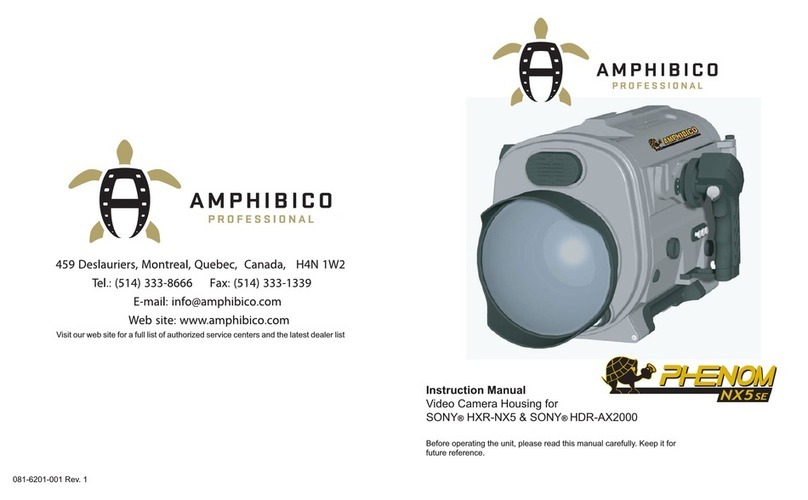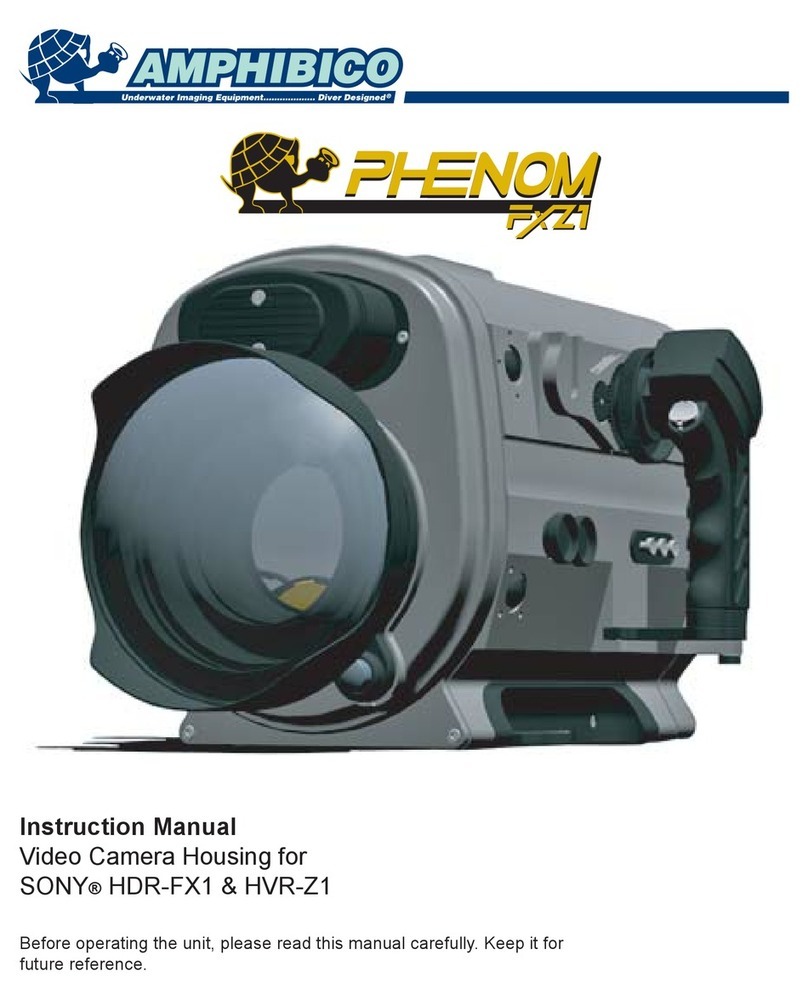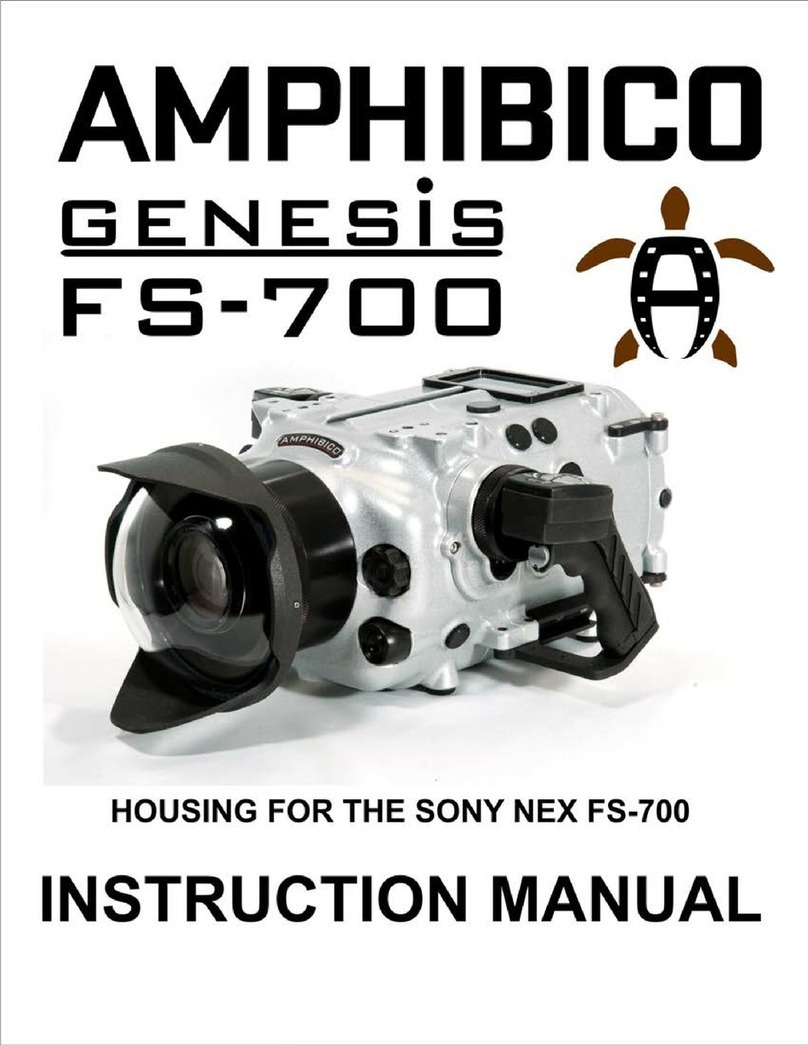
PREPARATION OF THE HOUSING
1) Opening the housing:
Three stainless steel safety latches hold securely the front and rear of the housing. They have a positive locking mechanism, so to open them you must rst
depress the metal tab in the center of latch while pulling on the rear of latch lever. Once both housing sections are separated, remove the camcorder saddle
from rear portion of housing.
2) Lubricate the Main O-ring Seal:
Before use, carefully inspect the Main O-ring seal from in its groove on the rear half of the housing to conrm that it is free from scratches or foreign material.
Lubricate the O-ring with a light coat of silicone grease. When replacing the O-ring place the entire O-ring over the O-ring groove and start by pushing the
O-ring in the corners. Work your way around the O-ring making sure the O-ring is snugly sitting in the groove.
NOTE: When replacing your O-rings, make sure you are using the o-rings provided with the package. Using different o-rings than those in the o-ring kit may
cause the housing to leak and result in damage. For proper handling and maintenance of O-rings be sure to read the section titled “Care and Maintenance:
of the O-rings.”
3) Attach grip supports & grips to the housing:
The housing comes with two grips and two grip support brackets for both right and left hand grips. First attached the 2 hand grips to support brackets with the
provided hex bolts. Then position the support brackets which attach to the underneath of the housing on the left and right side, use the 4 screws supplied and
Allen key. Occasionally remove the grips and lubricate the screws (see Care and Maintenance: of the housing.) Depending on which light arm system you
are using, you can mount the necessary shoes or brackets onto the 1/4”-20 threaded holes on the top of the hand grips. The AQUATICA TLC arm system is
recommended.
There is also a 1/4”-20 threaded hole on the bottom of the housing that can be used for various mounting application trays or tripod.
(See the entire selection of TLC arm systems on the Aquatica website,www.aquatica.ca)
PREPARATION OF THE CAMCORDER
1) Your Sony camcorder will need some preparation before it is installed in housing.
- Remove any lens caps or external converter lenses you may have attached to your camcorder.
- Tighten hand strap to its smallest position, so it allows for easy clearance when sliding in camcorder.
- Install Memory card and fully charged battery. (housing will accept up to the NP-FV70 battery)
- Turn on camcorder and proceed to photo mode menu, than turn off ash, its located in the photo settings
under FLASH MODE, this will prevent the ash from ring when taking a picture while camcorder is in the housing.
2) Installing the camcorder into housing:
- Open the camcorder LCD fully and slightly angle it about 20˚, place on to saddle, (photo #1). Tighten the
bottom thumbscrew with a coin or a screwdriver securely (photo #2).
- Camera should now be set and mounted on saddle, and ready to be placed inside rear half of housing.
- Line up camcorder and saddle with the 2 dowel pins inside of housing, slide in until saddle is well seated on both
pins,(photo #3)
- Slide open the small door on back right side of camcorder (MIC plug in power), to expose the Red
microphone input jack, plug in the hydrophone cable.
- You can now slide the camcorder all the way to the rear of housing, the saddle should lock in place (photo #4).
3) Installing the Sony remote commander (supplied with camcorder)
Remove the 2 remote control retaining screws on the Remote Control Cover (item #2 & #25, page 2) then:
- Remove the Remote Control Cover
- Place the Sony remote commander inside housing on to metal support craddle, make sure the infra red
sensor is facing the front of housing.
- Place back the Remote Control Cover, make sure sealing surface is free of dust and debris, you can
slightly lubircate if needed, also inspect the o-ring on the Remote Control Cover, make sure it is clear of
any debris and dust.
- Place back the 2 retaining screws tighten securely with provided Allen key.
4) Closing the housing:
Before closing the housing always ensure that:
1. The main O-ring on the rear half of the housing is clean, lubricated and properly seated for a positive seal.
2. The sealing surface on the front half of the housing is clean and free from any scratches or physical damage.
3. All cords or wires are tucked in so that they do not interfere with the closing of the housing.
- Place front section of housing onto the rear half. You will notice clearly when the housing halves are perfectly align and seated together properly.
- Locate and close the two left and right latches at the same time, than close the third latch located on top of the housing.
(NOTE: Make sure all three latches are closed and locked prior to use to avoid accidental opening of the housing underwater.)
- Carefully inspect the parting line between front and rear of housing. Make sure the line is even all the way around, if not open the housing and determine the
reason. (O-ring not seated in place, hydrophone cable interference. etc.) Failure to do this may result in a water leak which can cause camcorder failure.
- Power up the camcorder, check all controls for the proper operation before entering the water.
page 5
Photo #1
Photo #2
Photo #3
Photo #4




































